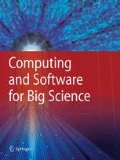Abstract
The effective utilization at scale of complex machine learning (ML) techniques for HEP use cases poses several technological challenges, most importantly on the actual implementation of dedicated end-to-end data pipelines. A solution to these challenges is presented, which allows training neural network classifiers using solutions from the Big Data and data science ecosystems, integrated with tools, software, and platforms common in the HEP environment. In particular, Apache Spark is exploited for data preparation and feature engineering, running the corresponding (Python) code interactively on Jupyter notebooks. Key integrations and libraries that make Spark capable of ingesting data stored using ROOT format and accessed via the XRootD protocol, are described and discussed. Training of the neural network models, defined using the Keras API, is performed in a distributed fashion on Spark clusters by using BigDL with Analytics Zoo and also by using TensorFlow, notably for distributed training on CPU and GPU resources. The implementation and the results of the distributed training are described in detail in this work.








Similar content being viewed by others
References
Zaharia M, Chowdhury M, Franklin MJ, Shenker S, Stoica I (2010) Spark: Cluster computing with working sets. In: Proceedings of the 2Nd USENIX Conference on Hot Topics in Cloud Computing. HotCloud’10. USENIX Association, Berkeley, p 10
Baldi P, Sadowski P, Whiteson D (2014) Searching for exotic particles in high-energy physics with deep learning. Nat Commun 5:4308
Dai J, Wang Y, Qiu X, Ding D, Zhang Y, Wang Y, Jia X, Zhang C, Wan Y, Li Z, Wang J, Huang S, Wu Z, Wang Y, Yang Y, She B, Shi D, Lu Q, Huang K, Song G (2018) BigDL: a distributed deep learning framework for big data. arXiv e-prints, arXiv:1804.05839
Nguyen TQ, Weitekamp I, Anderson Daniel D, Castello R, Cerri O, Pierini M, Spiropulu M, Vlimant J-R (2019) Topology classification with deep learning to improve real-time event selection at the LHC. Comput Softw Big Sci 3:12
Brun R, Rademakers F (1997) Root - an object oriented data analysis framework. Nucl Instrum Methods Phys Res Sect A 389(1):81–86 (New Computing Techniques in Physics Research V)
Bird I, Buncic P, Carminati F, Cattaneo M, Clarke P, Fisk I, Girone M, Harvey J, Kersevan B, Mato P, Mount R, Panzer-Steindel B (2014) Update of the computing models of the WLCG and the LHC experiments. Tech Rep CERN-LHCC-2014-014. LCG-TDR-002
Hoecker A, Speckmayer P, Stelzer J, Therhaag J, von Toerne E, Voss H, Backes M, Carli T, Cohen O, Christov A, Dannheim D, Danielowski K, Henrot-Versille S, Jachowski M, Kraszewski K, Krasznahorkay JA, Kruk M, Mahalalel Y, Ospanov R, Prudent X, Robert A, Schouten D, Tegenfeldt F, Voigt A, Voss K, Wolter M, Zemla A (2007) TMVA - toolkit for multivariate data analysis. arXiv e-prints, p. physics/0703039
Peters AJ, Janyst L (2011) Exabyte scale storage at cern. J Phys 331:12
Khristenko V, Pivarski J (2017) diana-hep/spark-root: Release 0.1.14.
CERN-DB (2013) Hadoop-XRootD connector. https://github.com/cerndb/hadoop-xrootd
Apache Hadoop project. https://hadoop.apache.org/
Apache Parquet. https://parquet.apache.org/
Google, Protocol buffers. http://code.google.com/apis/protocolbuffers/
Scikit-learn. https://scikit-learn.org/
Keras tuner. https://keras-team.github.io/keras-tuner/
Kubernetes. https://kubernetes.io/
Chollet F et al. (2015) Keras. https://keras.io
CERN openlab. https://openlab.cern/
Analytics Zoo. https://analytics-zoo.github.io/
TensorFlow. https://www.tensorflow.org/
TF-Spawner. https://github.com/cerndb/tf-spawner
Goyal P, Dollár P, Girshick R, Noordhuis P, Wesolowski L, Kyrola A, Tulloch A, Jia Y, He K (2017) Accurate, large minibatch SGD: training ImageNet in 1 hour. arXiv e-prints arXiv:1706.02677
High Luminosity LHC Project. https://hilumilhc.web.cern.ch
Author information
Authors and Affiliations
Corresponding author
Additional information
Publisher's Note
Springer Nature remains neutral with regard to jurisdictional claims in published maps and institutional affiliations.
Rights and permissions
About this article
Cite this article
Migliorini, M., Castellotti, R., Canali, L. et al. Machine Learning Pipelines with Modern Big Data Tools for High Energy Physics. Comput Softw Big Sci 4, 8 (2020). https://doi.org/10.1007/s41781-020-00040-0
Received:
Accepted:
Published:
DOI: https://doi.org/10.1007/s41781-020-00040-0




